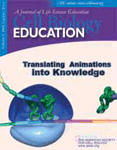Molecular and Cellular Biology Animations: Development and Impact on Student Learning
Abstract
Educators often struggle when teaching cellular and molecular processes because typically they have only two-dimensional tools to teach something that plays out in four dimensions. Learning research has demonstrated that visualizing processes in three dimensions aids learning, and animations are effective visualization tools for novice learners and aid with long-term memory retention. The World Wide Web Instructional Committee at North Dakota State University has used these research results as an inspiration to develop a suite of high-quality animations of molecular and cellular processes. Currently, these animations represent transcription, translation, bacterial gene expression, messenger RNA (mRNA) processing, mRNA splicing, protein transport into an organelle, the electron transport chain, and the use of a biological gradient to drive adenosine triphosphate synthesis. These animations are integrated with an educational module that consists of First Look and Advanced Look components that feature captioned stills from the animation representing the key steps in the processes at varying levels of complexity. These animation-based educational modules are available via the World Wide Web at http://vcell.ndsu.edu/animations. An in-class research experiment demonstrated that student retention of content material was significantly better when students received a lecture coupled with the animations and then used the animation as an individual study activity.
INTRODUCTION
Over the last decade or so, the unifying approach of many biology courses has evolved from an emphasis on the whole organism to a concentration on the molecular and cellular basis of life. This change reflects the recent shift in biology research toward an approach that addresses questions of function, structure, development, and evolution at the molecular and cellular levels. To reflect these discoveries, students in freshman-level general biology courses are taught that organisms are made of cells, that eukaryotic cells are compartmentalized into organelles while prokaryotic cells are not, and that cellular life is maintained by molecular and cellular processes. Naturally, the complexity of these processes and their interrelation is often difficult for the novice student to understand. For example, students learn that an essential process such as RNA transcription involves RNA polymerase, but the fact that RNA polymerase itself is actually a multimeric protein complex is often not understood. Students also may not realize that RNA polymerase does not act alone, but rather that it is one component of the transcription process that involves several multiprotein complexes, and that each complex plays an essential role in the production of RNA.
This one example exposes a shortcoming in curricular delivery: students struggle to visualize the complexities underlying the most essential molecular and cellular processes. A major challenge to biology educators is to teach these processes so that students can comprehend and understand their complexity. Because of this challenge, many instructors no longer simply lecture in class and assign readings from principal textbooks. Most are looking for new approaches that enhance student learning of biological processes. The use of visualization is significant among these approaches.
The Value of Visualization, Graphics, and Animations in Learning
Student learning research has shown that visual perception is the most developed sense in humans and is an important way by which we learn (Sekular and Blake, 1985). Vision allows us to collect and process information from our environment and to make decisions or form concepts from that information. From an educational perspective, visualization aids student understanding of complex processes because it assists in the conversion of an abstract concept into a specific visual object that can be mentally manipulated. Further research has shown that by using well-designed visual tools, students can digest large amounts of information in a relatively short time and construct their own personal visualization of a process (Kraidy, 2002; Linn et al., 1996).
Graphical representations are visualizations that augment the information presented in text by providing a focus for the learner (Mayer, 1989). They are most effective when they support content for which the learner has little prior knowledge (Mayer and Gallini, 1990). Computer animation, in particular, is a new educational tool that fosters long-term learning by calling attention to objects during the early steps of instruction (Gagné, 1985; Rieber, 1994).
Rieber (1994) demonstrated that using animations to communicate ideas and processes that change over time reduces the abstractions associated with the temporal transitions of the process. The value of graphics appears to be associated with the dual-coding theory (Paivio, 1979, 1991), which suggests that long-term memory retention is facilitated by a combination of verbal and visual cues. As such, animations are valuable aids in supporting the visual aspects of long-term memory. Furthermore, by combining narration and animation, dual-coding is further supported (Mayer and Anderson, 1991).
Motion distinguishes animation from static, still images and provides a smooth transitional representation that captures the critical interrelationships along the path of a specific process. Motion leads to longer-term memory, an effect not observed with static images (Goldstein et al., 1982). This result is most dramatic for individuals who have difficulty grasping spatial relationships (Blake, 1977).
Although research has clearly shown that students learn more from animations than from static images, this is maximized by lesson plans that include lecture and other learning inputs (Rieber, 1990). According to the dual-coding theory (Paivio, 1979, 1991), learning is best achieved when an animation is coupled with a lecture, because this combination provides a reference from which students can appreciate the knowledge presented in the animation. The lecture cues students while they are studying the animation.
Visualization in the Biology Classroom
Visualization is a valuable tool in learning scientific topics (Gordin and Pea, 1995) because it helps learners with important conceptual relationships (Brodie et al., 1992). In the modern classroom, the teacher uses several visualization tools while teaching. By drawing on a blackboard or overhead acetate, attention can be drawn to the structures or molecules involved in a process. This is certainly useful for naming the components and providing a rough approximation of their relative orientation at the beginning of a process. But this approach is not effective when we attempt to illustrate how these molecules or structures interact. After all the details of the interaction are illustrated on the board, what often results is an unordered drawing consisting of a complex series of lines and arrows pointing to or from the different objects. While this may make sense to a more experienced student, it is not as informative to the first-time learner.
Multimedia tools provide another level of sophistication. Slide shows that use a presentation package such as Microsoft PowerPoint can provide a step-by-step graphic representation of a process. Individual molecules can be added, and specific interactions can be highlighted. The advantage of this tool is that the instructor or learner can move forward and backward one step at a time during the learning process and emphasize key transitions. Yet, the final slide is still a complex display that takes concentrated study to grasp.
Animation illustrates the transitional states of a process. This visualization technique is effective if the objects capture the complexity of the individual components and how they interact. Most current biology textbooks contain CDs with animations that are flat, two-dimensional (2D) characterizations of complex processes. Because they are flat, important spatial relationships of the process are not captured.
The most effective visualizations reveal the complexity of the objects involved in the process, illustrate how and where the objects interact, provide a spatial representation of the molecules during the process, and smoothly represent the transitional states the objects undergo during the length of the process. High quality, 3D representations have all of these attributes.
VIRTUAL CELL ANIMATION COLLECTION
Our development group, the World Wide Web Instructional Committee (WWWIC) at North Dakota State University (NDSU), was inspired by research that demonstrated the educational value of animations (Kraidy, 2002; Rieber, 1994; Mayer and Anderson, 1991). The goal of the Virtual Cell (VCell) animation project is to create high-quality animations of selected molecular and cellular processes that support student learning. They are also used as references to create interactive 3D simulations of these processes for immersive, role-based learning (McClean et al., 2001; Slator et al., 2002).
The choice of animations was informed by workshops held with university and grade 7-12 science teachers who were asked to identify cellular processes that would be best supported by high-quality animations. In particular, we were interested in processes that interact along a molecular or cellular continuum, and that typically cause students extra problems. For example, transcription provides messenger RNA (mRNA), the key “information molecule” used during translation to produce protein. Therefore, it was natural to couple the development of the transcription and translation animations.
A decision was made to develop animations at a level of detail that would be understood by an advanced undergraduate or graduate student. For example, the transcription animation ( http://vcell.ndsu.nodak.edu/animations/transcription/) shows all the major protein complexes that interact to initiate the process. (See Figure 1 for stills of one section of the animation.) Most of these are represented as multiprotein complexes. This provides a level of detail from which interactions among components of a complex can be derived. With this level of detail, instructors have several options. First, they can show the process and teach only the major events. Although students will be asked to focus only on these events, the complexity is still in their visual field. This strategy allows students to realize that more is going on than they are being asked to learn. Alternatively, students may be required to study the full breadth of details. Our strategy of developing animations with different depths supports teachers who have different learning objectives for their students.
The animation will be especially useful to an instructor during the lecture. While guiding students through the appropriate level of detail for that class, instructors will have the opportunity to comment on the underlying complexity of the process. The level of detail built into these animations also makes them appropriate for more advanced classes. For example, the transcription animation contains sufficient detail to aid instructors teaching an advanced undergraduate- or graduate-level course in cell biology, molecular biology, or genetics.
Studying the same animations in several courses offers students a level of familiarity that will also aid in learning. At first, the completed animations were made available as stand-alone objects. But as noted in the research discussed above, animations best support learning when they are contextualized by a complete educational experience (Mayer and Anderson, 1991). Therefore, value is added by offering the animations as part of a Web-based educational module.
The First Look WWW component of the module presents the process at a level appropriate for a college freshman general biology class. The student first encounters a series of stills captured from the animation (Figure 2). As an example, the RNA transcription First Look component can be found at http://vcell.ndsu.nodak.edu/animations/transcription/first.htm. Users can also click on stills representing the key steps of the process to view a larger image that contains information bubbles highlighting important points for that particular step in the process. By stepping through the stills, students are introduced to the process. Finally, students can view a narrated animation that focuses on the key concepts featured in the First Look stills. By combining what they learn in the classroom with the visualization and narration of the animation, students are exposed to the process from a number of different perspectives. And because the learning modules are delivered via the WWW, students can reinforce their learning by revisiting the site at any time.
To provide greater detail for more advanced students, each module also contains an Advanced Look component (Figure 3). The primary difference between this component and the First Look component is content depth. Here, the stills and their hyperlinked enlargements contain the depth of material found in an advanced undergraduate or graduate course. By comparing Figures 2 and 3 and visiting http://vcell.ndsu.nodak.edu/animations/transcription/advanced.htm, one can navigate through the different stills and see the differences between the First Look and Advanced Look presentations.
Figure 1. A series of stills from the transcription animations developed by the NDSU WWWIC VCell animation project ( http://vcell.ndsu.nodak.edu/animations).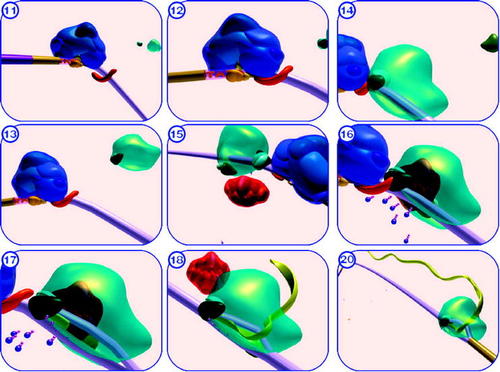
Animation Development Cycle
The first step in animation development is to create representations of the different molecules and complexes involved in a particular molecular or cellular process. These representations are based on current knowledge of the composition and orientation of the multiple proteins that make up the complex. In general, we begin by studying the representations published in graduate-level cell and molecular biology textbooks such as Molecular Biology of the Cell (Alberts et al., 2002). We next study recent review articles that describe a process in full detail and use that current information to inform our animation development (Table 1). In addition, we use individual publications referenced in a review article to provide further details. We use the Protein Data Bank (PDB; http://www.rcsb.org/pdb/) to visualize the structure of multidomain complexes and the general overall shape of individual proteins. We view the structures with the Protein Explorer software available at the PDB. This provides a level of detail by which interactions among components of a complex are derived.
Figure 2. First Look animation stills (left) and annotated enlarged versions (right) of the animation stills. The stills are captured from the animations and illustrate major events in the process. A) Building the RNA polymerase complex. B) Early stages of transcription.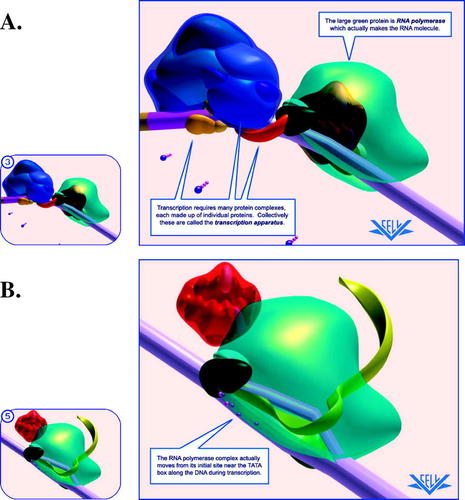
To guide the artists, a storyboard is developed that represents the steps in a process. Figure 4A shows a single frame from a storyboard. The development of the storyboard requires several key pedagogical decisions. The first is to decide the level of detail that should be used to represent each major complex or molecule. This decision is made based on the specific topic we are trying to represent. For example, it was our decision to concentrate on the movement of electrons through the three major complexes, and the associated hydrogen pumping and water production during electron transport ( http://vcell.ndsu.nodak.edu/animations/etc/). Because the actual interactions of the electrons and protons with different components of the complex are rarely taught at the beginning or advanced undergraduate level, the complexes are represented simply as large objects, and substructure detail is not presented. Yet for mitochondrial adenosine triphosphate (ATP) synthesis ( http://vcell.ndsu.nodak.edu/animations/atpgradient/), the structure of ATP synthase is a key aspect of how ATP is produced. For example, an important concept in ATP synthesis is the location at which protons enter and leave the ATP synthase complex. In addition, because hydrogen pumping and ATP synthesis are spatially distributed relative to the cellular location of the key molecules (protons and ADP and Pi), we felt it necessary to faithfully represent the known structure of the ATP synthase complex.
Figure 3. Advanced Look animation stills (left) and annotated enlarged versions (right) of the animation stills. The stills are captured from the animations and illustrate major events in the process. A) Activation of the transcription start site. B) Transcription initiation.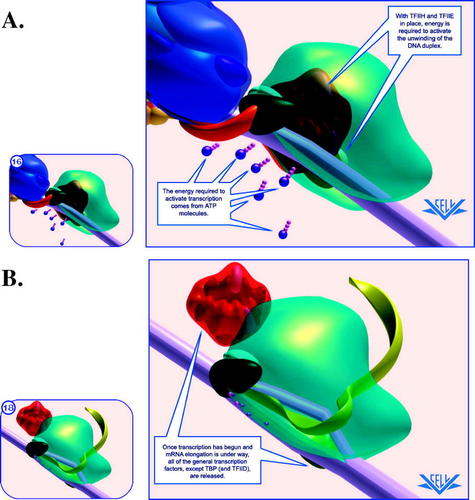
To expedite the development process, objects are reused whenever possible. For example, both the transcription and Lac Operon animations use the same RNA polymerase and ribosome objects. In addition to speeding up the development process, reusing the same objects provides all-important consistency and a degree of familiarity. It also provides students with a visual understanding that all processes are part of a continuum of steps that are interrelated.
Using the storyboard as a guide, the artists use Alias Maya software (Toronto, Canada) as the animation development tool. Maya is a state-of-the-art software package used to develop high-quality animations. Currently, it takes an artist about 200 hours to complete an animation and an additional 40 hours to implement the WWW pages used to deliver the learning module. As the group develops more expertise, it is predicted that it will take 200 hours to fully implement each new module. The list of the completed (or nearly completed) animations appears in Table 2.
VCell Animations Improve Student Learning
The results of a meta-analysis conducted by Liao (1999) suggest that, as a whole, student learning is greater when a multimedia learning tool is included during instruction relative to a control group without such tools. As Mayer and Moreno (2002) describe the situation though, research on whether one form of multimedia is a better aid for student learning than another has been inconclusive. It is not our goal to determine whether animation is better than 2D animations (such as might be developed and presented in Microsoft PowerPoint) or well-designed and executed board drawings. In addition, it is not our intent to measure effects relative to the value of student learning using such distance education methods as video captures of an instructor's lecture. Rather, we were interested in determining the best method or methods of incorporating animation into the learning of cell biology. Therefore, our research question is: “What is the most effective instructional use of a cell biology animation?” To address this question, student retention of content material was tested relative to several animation scenarios.
Experimental Design
Animations are typically used by a teacher as a lecture supplement in the classroom or by students as individual learning tools. Both of these learning approaches are supported by research demonstrating that animations significantly improved student learning (Kraidy, 2002; Mayer 1989; Rieber, 1994; Mayer and Anderson, 1991; Mayer and Gallini, 1990; Mayer and Moreno, 2002). Our experimental design is similar to those described in these reports (see Mayer and Moreno, 2002 for a summary). To determine the effectiveness of the animations described here, the protein translation animation was tested during the Spring 2004 semester at NDSU with the Education 321 (Introduction to Teaching) class. This class is required of all education majors at NDSU and typically includes a mixture of students training to be teachers in the full range of grade 7-12 disciplines. It is therefore an appropriate group on which to test the value of the animations to aid in the learning of a complex topic by a diverse group of students.
The narrated Protein Translation animation lasts 187 s. It begins with a credit section that is 19 s long. The remainder of the animation is narrated by a female voice. A 25-s narrated introduction defines translation; names the molecules involved in the process while showing revolving images of each molecule; and names the three major steps of translation: initiation, elongation, and termination. The main body of the narrated animation is 131 s. The major components of the process are labeled on screen in the immediate proximity of the component as it is being discussed.
Students were divided into four experimental groups. Each group received a traditional lecture and performed an individual study, but the order differed for these experiences among the four groups. Depending on the group, the lecture was augmented with either overhead transparencies or the protein translation animation. The overheads supported the same lecture content that was emphasized in the animation and consisted of the translation figures found in the student textbook. To ensure consistency in presentation, the same instructor presented all lectures. Each lecture was recorded and studied to confirm that the same topics were indeed presented in the different lectures, and that the topics were presented in the same order. The overhead and animation were both introduced at the same points during the lecture. The individual study materials were either 1) the protein translation text and figures from the book used in the General Biology class at NDSU, or 2) the animation described above. The students listened to the animations through individual headphones and were allowed to study the materials for up to 25 min. Students were allowed to study the text material for 25 min.
Following the last activity of the treatment, each student completed a multiple-choice (Figure 5) test consisting of four questions that addressed the major aspects of protein translation that were emphasized in the lecture and supported by the animation, overheads, and text material. The students completed the same test prior to the treatment. In addition, during the pretreatment and post-treatment tests, students completed a confidence rating for each of their four answers. Confidence was rated as follows: 1 = low, 2 = medium, and 3 = high. The pretreatment and post-treatment performance and confidence level data, measured as sum totals, were analyzed using single-factor analysis of variance. The p value to test the mean difference between each pair of treatment groups was also calculated following rejection of the null hypothesis that all treatment means were equal. Finally, prior to all treatments, the students completed a survey to determine the number of science courses they had taken and whether they had completed an introductory college-level biology course. The number-of-courses data were analyzed as a single-factor analysis of variance, while a chi-square homogeneity test was used to determine group effects regarding the proportion of students who completed an introductory biology course.
With a limited number of students available for our experiment, we could create only a limited number of treatment groups, which in turn allowed us to consider only select hypotheses relative to the value of animations in student learning. In each case, the null hypothesis was that there was no difference in treatment effects, whereas the alternative hypothesis was that treatment effects existed. We chose individual student study of course materials prior to a lecture followed by a lecture augmented with overheads that consisted of figures from the textbook as our baseline educational experience (group D; Table 3). Three other treatments were included relative to our research objectives (Table 3).
Figure 4. A comparison of a flat 2D (A) and a 3D (B) representation of the same set in the mRNA transcription process. These are 1997 (A) and 2003 (B) vintage graphics from the WWWIC Virtual Cell animation project and presented to show the level of sophistication new software tools offer.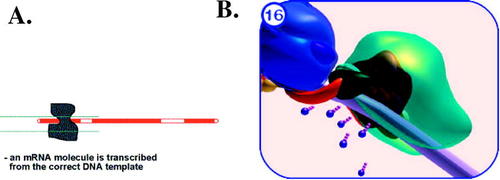
Of primary interest were the following hypotheses: 1) We were first interested in determining whether including animation as a component of the educational experience improves student learning. Comparing groups A, B, and C with group D could test this hypothesis. 2) Next, we were interested in determining whether there was an effect on student learning relative to the number of times a student was exposed to the animation. This was tested by comparing the performance of group A versus the other three groups (two versus one or zero animation activities), and comparing groups B and C with group D (one versus zero animation activities). 3) Next we considered whether, relative to our standard educational experience, adding animation to the lecture improved student retention (group B versus group D). 4) Students often are first exposed to a topic in class and then study the material outside of class. We were finally interested in determining whether exposure to an animation in class prior to individually studying the animation improved student learning (group A versus group C).
Experimental Results
Statistical tests were performed to determine whether the four groups were demographically equal with regard to completing an introductory biology course and the number of science courses taken. A chi-square test of homogeneity was performed on the proportion of students within each group that had completed an introductory biology course. The result of this test was not significant (p = .257). Similarly, a one-way analysis of variance was performed to test for differences among experimental groups for the number of science courses taken. There was no significant difference (p = .504) among the four groups. Taken together, these results suggest the groups were equivalent with regard to science and biology training.
When the pretreatment test scores among the four treatment groups were compared, no significant difference among the means was detected (p = .489). By contrast, a significant group effect was noted for both the post-treatment mean (p = .005) and the difference between the post-treatment and pretreatment means (p = .012). To determine which treatments were most significant and to allow us to address the specific hypotheses we were testing, the p value associated with each pairwise contrast was calculated (Table 4).
Group A, in which students heard a lecture augmented with the animation followed by an individual study of the animation, performed significantly better than any other group. (Note that all treatment contrast p values were,.05.) Yet, the performance of groups B and C (which contained a single animation activity) was not significantly different from that of group D, a treatment that did not have an animation component. Collectively, these results allowed us to conclude the following relative to hypotheses 1 and 2: first, these results strongly suggest that the animation was a significant component in improving student retention of content material, but this effect was noted only when the students experienced two animation activities. This demonstrates that the best practice for using animations in learning would involve its incorporation both during the lecture and as an individual study aid.
The other hypotheses considered the effect of animations relative to a standard educational experience in which a student studies course materials from the text prior to class and then listens to a lecture that is supported by overheads containing graphics found in the textbook. We first considered the effect of simply adding the animation to the lecture (hypothesis 3). That the performance of groups B and D did not differ demonstrates that simply adding the animation to the lecture did not produce a positive (or negative) effect on student learning. Students often do not study prior to class; rather, they listen to a lecture and then follow that up with individual study. Given this learning scenario, we were next interested in determining the effect of introducing a topic in class with animation versus overheads when students subsequently studied the topic using the animation (hypothesis 4). By comparing the performance of groups A and C, we determined that introducing a topic with animation leads to significantly improved student retention.
Figure 5. The pretreatment and post-treatment retention test.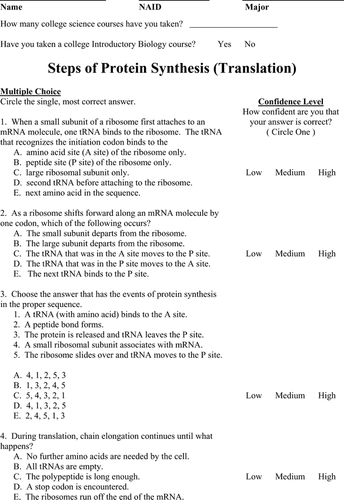
Although we were able to address important questions relative to the role of animation in student learning, other questions could not be considered because of the size of our experimental group. For example, although we did determine that student learning was significantly higher with two animation experiences, we did not address learning relative to the order in which the animation is introduced to a student. Specifically, we did not determine whether content retention differed if the student first heard a lecture supported by an animation followed by individual study of the animation versus first studying the animation and then hearing a lecture that incorporated the animation.
To test this possibility, we designed another experiment using the students from the fall 2004 NDSU Education 321 (Introduction to Teaching) class. The experimental design was the same as for the spring 2004 experiment described above. This experiment showed that there was no significant difference in the postexperience minus pre-experience test scores (p = .07). When the spring and fall 2004 experiments are considered together, we can conclude that a student learns best when the lecture and individual study contained an animation component and that student retention was equal regardless of the order in which the animation is presented.
The confidence level for test answers gave a somewhat different result (Table 5). There was no significant difference in self-reported confidence among the four groups during the pretreatment test (p = .3424). On the other hand, there was a significant confidence difference among the groups with the post-test (p = .001). When individual group comparisons were made, it was observed that the mean confidence level of group D (individual study of text material followed by a lecture supported by overheads) was significantly less than all other groups. No other comparisons were significant. Significant group effects were also noted for the post-treatment minus pretreatment confidence level data (p, .001). As before, the confidence of any group that contained an animation activity (groups A, B, and C) was significantly greater than that of group D, which did not have animation to support learning. Although the data are not entirely consistent, one observation can be made: student confidence in their answer is significantly improved when an animation is used at some point during the educational experience. These results are consistent with those presented by Rieber (1990), who also showed that augmenting both a lecture and individual study materials with animation significantly affected student learning.
In general, the experimental results are consistent with other research that suggests animation supports improved student learning (Rieber, 1990; Mayer and Moreno, 2002). Yet at this point, it is difficult to determine whether the narration or motion aspect of the animation is strengthening dual-coding. The dual-coding theory states that learning is enhanced by verbal and visual images. In turn, verbal information in the form of a lecture or narration is strengthened by visual inputs. The overheads used in the lecture format and the figures that supplemented the individual study contained the same content material as the animation. Yet student learning was greater with animations, which are, in essence, the same collection of static images enhanced by motion and narration. A more sophisticated design and modifications to the animations are necessary before the effects of narration, motion, or both on dual-coding can be further evaluated.
Applications of the VCell Animation Collection to Student Learning Research
The value of the animations to significantly affect learning suggests they can be of value in further research on the specific effects of certain aspects of multimedia on learning. The model proposed by Hede (2002) suggests that a visual input such as an animation is a major factor in drawing attention to a topic, which in turn acts as a stimulus to transfer the content into working memory. The model also suggests that narration has the same effect as animation. A future study in which our animations are presented with or without narration can serve as an appropriate test for this model.
Mayer and Moreno (2002) describe seven animation design principles that support learning. The results presented here support their “Multimedia Principle,” which states that animation and narration lead to deeper learning than a narration in the form of a lecture. Because our animations can be quickly modified and re-rendered, other principles can be tested. For example, by removing the narration from the animation and presenting it in alternative format (in lecture, for example), the “Temporal Contiguity Principle” can be tested. The animations contain static textual information. By removing this text, it can be determined whether the “Redundancy Principle,” which states that student learning is deeper if on-screen text is absent, applies to our animations. Similarly, by substituting on-screen text for narration, the “Modality Principle” can be tested.
From a broader educational policy perspective, we have developed an effective set of tools that will allow us to address specific questions relative to educational technology. The No Child Left Behind Act of 2001 specifically asks for proof that educational technology is effective ( http://www.ed.gov/about/offices/list/os/technology/evaluation.html; accessed on 28 June 2004). Certainly, animation appears to be an important technology designed to support education. We have already shown that test scores of content material are improved by the use of animations. With further research, we can better identify specific resource needs and practices in which animations best support student learning.
FOOTNOTES
Monitoring Editor: Dennis Liu
ACKNOWLEDGMENTS
The National Science Foundation (award 0086142) and the Department of Education (award P116B000734) provided funds for this development and research project. The authors gratefully acknowledge that support.


